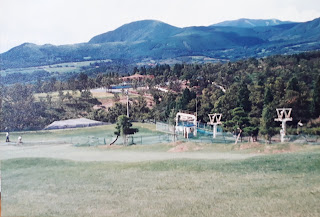A few days later Ishizono San came to me
and with Tomomi’s help explained I was going for a 3 day outing to the
Kirishima Mountains with about 20 students from the English Club at one of my
assigned high schools. We were going on
the bus along with a few teachers and a vice principal to a ryokan (Japanese Inn) in a scenic area
about 3 hours from Kaseda. At last, an
out of the office adventure, and I would get to meet some teachers and some
students. Another school was also
sending a bus of students and teachers from a nearby town and another ALT from
the UK would also be there. I had met
Mark briefly. He was very witty, had
fluent Japanese and was good friends with Brian.
We had a noisy ride and the students were
all in high spirits. The scenery was
wonderful; we rode past rice fields and climbed into mountains with cedar and
pine trees, finally arriving at an old but lovely inn. I managed a misstep soon after entering and
felt like I got hammered as a result of Japanese culture.
In Japan most entrances (genkan) to homes or old shops have a
step up into the main level. The lower
entry is where everyone leaves their shoes. The hotel actually had slippers that you slid
into when you left your shoes, neatly lined up in a row. I knew about this already, but in the case of
the hotel entry, the step up was only about an inch and not that obvious. I was studying a pretty heron sculpture, and
as I walked toward it fell off the one inch step. I went down hard for some
weird reason, perhaps the slippers, and I swore I broke a bone in the bottom of
my foot. It left me limping, not only
throughout the trip to the ryokan,
but for months later.
(At the doctor’s office the next week a
technician took 7 x-rays, then I asked to put on the lead vest hanging in the
corner. He took 4 more and they never
found any evidence of a fracture. They
gave me a soft wrap cast which I wore for months, and since I still had to keep
walking to the office and later to school, it didn’t seem to heal. Fractured or not, I still get pain in the
same spot during cold, damp weather.)
At the ryokan we had a meeting and
introductions, some pleasant exchanges in English and then a bit of free time
to explore the inn before dinner. Dinner
that first evening included many small dishes, with lots of food I did not
recognize. Again there was a full variety of small dishes of foods from the
mountain and the sea. Every meal in Japan usually includes a bowl of rice. We
were all seated on the tatami floor, and everyone was talking at once. It was quite pleasant, though I was not
enjoying miso soup with tofu. Back then
tofu wasn’t that common, especially in the eastern U.S., and I had never tasted
it. But I loved the thin steak served on
a sizzling flat stone. It was perfect.
The first evening’s entertainment took me
by surprise, and it will be detailed in the next post, Moonlight on Shoji.
Breakfast the next morning was also a
feast by Japanese standards, miso soup with tofu and wakame (seaweed), salad, pickled napa cabbage and daikon radish, sauces,
eggs and bacon which was served sizzling on a hot stone, and what I would call
a “dead fish”. It was grilled in a
perfectly curved arch, gutted but otherwise whole and at 7:30 a.m. it was
staring back at me. At least it was
cooked, but I really don’t start my mornings with things that look back.
We began with a short English class and
then went to Shinwa no Sato a nearby amusement park, with mini golf, grass skiing, some arts and
craft activities, shops, food booths and a small restaurant. Some of the students asked me to join them
(at the teacher’s urging) to make a bowl on the pottery wheels. Three of us worked on the wheels together, and
others watched and waited for their turns.
More chatter and laughter made for a pleasant afternoon. Some students were outside using the slope provided for grass skiing, and they had a great time.
The slope used for grass skiing.  |
| Kinyo was also brave and friendly. |
I was invited to join the vice principal, the teachers and Mark for a drink on the second evening in the teacher’s room, as we would board the bus after breakfast in the morning. I assumed that this evening the boys in the English Club would use the outdoor onsen. We all wore yukata, a kind of casual cotton kimono and sat on the tatami floor. I didn’t understand what was being said, but I understood I was probably being observed and assessed. I also began to understand that despite all of the formalities, especially with mostly older male teachers and the vice principal, a stern group to be sure, the warmth and friendliness of sitting on the floor in yukata eased any tensions for all of us.
The only female teacher that accompanied
us did not join us for this, so perhaps she would not have been comfortable in
the group and in the yukata. There were more divisions along gender than I
was able to grasp so early on, but they would become more apparent the longer I
stayed. I recognized, maybe not exactly at that moment, but in coming weeks, that
joining in was the best thing I could do, not whether I could do it well, but
just show up and keep smiling, and attempt some Japanese. Emotionally and mentally it would be the best
thing for me, too.







